Case Study: Partnership Law and Liability of Busy Bee Florist
VerifiedAdded on 2020/03/16
|6
|2239
|156
Case Study
AI Summary
This case study analyzes a legal issue concerning the partnership status and liabilities of individuals involved with the Busy Bee Florist shop. The assignment delves into the Partnership Act 1963, specifically Section 6 and Section 7, to determine whether Violet and Sunny can be considered partners. Violet provided a loan to the business in exchange for a share of the profits and access to the books, while Sunny, an employee, also lent money and received a share of the profits. The analysis considers relevant case laws such as Green v Beesley, Smith v Anderson, Davis v Davis, and Cox v Hickman to ascertain the existence of a partnership. The conclusion finds that Violet is considered a partner due to the circumstances surrounding her involvement, making her liable for the firm's debts. Conversely, Sunny is not deemed a partner, as his profit-sharing arrangement stems from his loan, not a partnership agreement. The document demonstrates an understanding of partnership law principles and their application to the given facts.
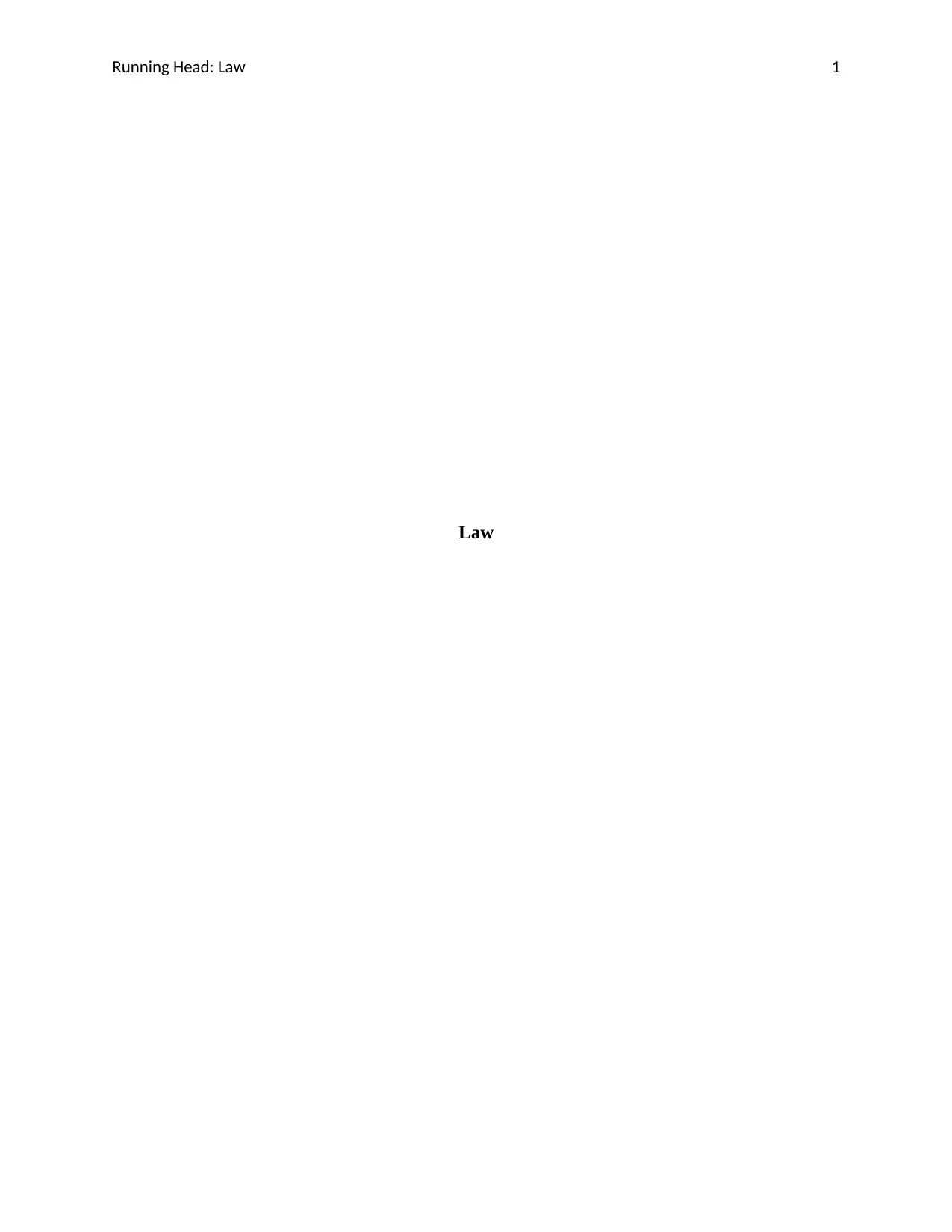
Running Head: Law 1
Law
Law
Paraphrase This Document
Need a fresh take? Get an instant paraphrase of this document with our AI Paraphraser
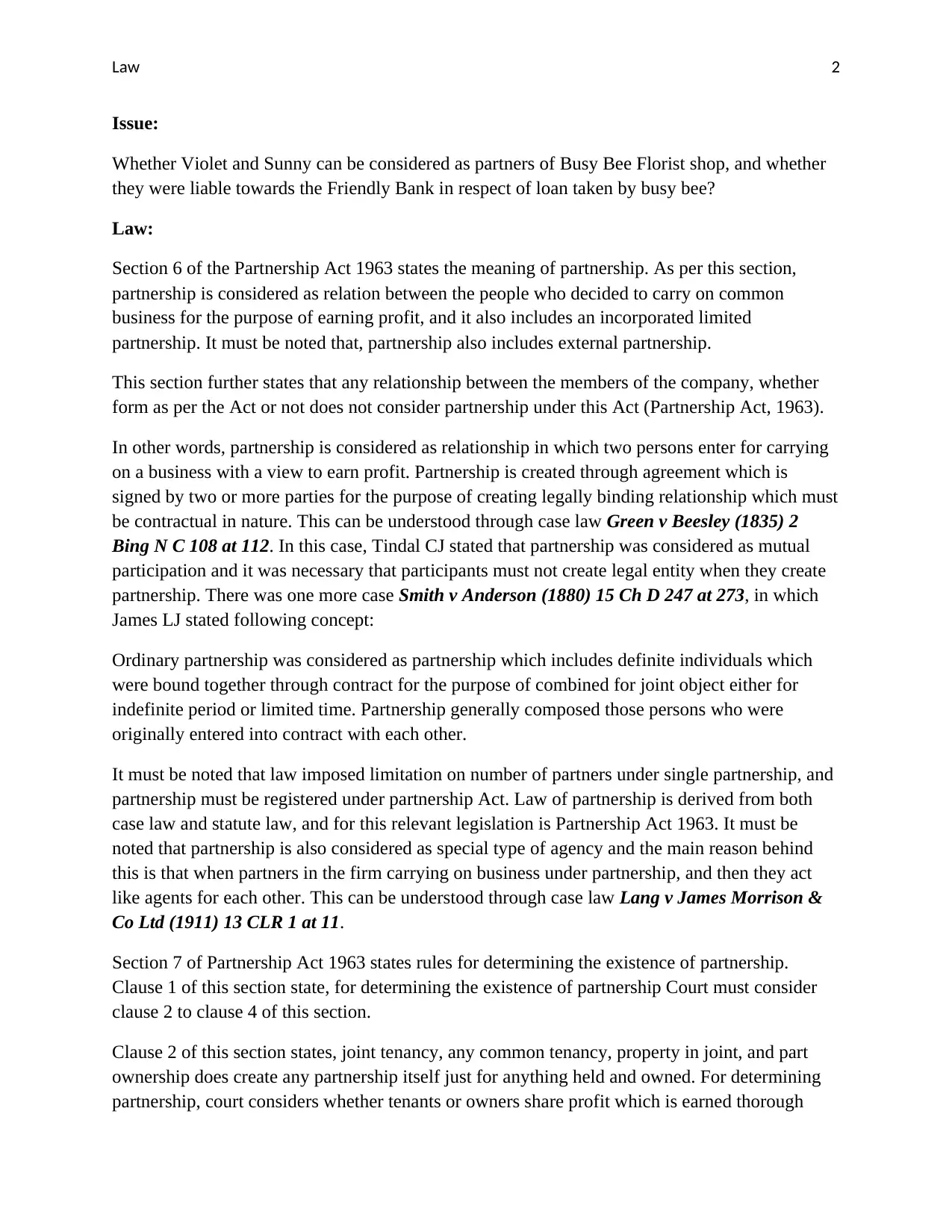
Law 2
Issue:
Whether Violet and Sunny can be considered as partners of Busy Bee Florist shop, and whether
they were liable towards the Friendly Bank in respect of loan taken by busy bee?
Law:
Section 6 of the Partnership Act 1963 states the meaning of partnership. As per this section,
partnership is considered as relation between the people who decided to carry on common
business for the purpose of earning profit, and it also includes an incorporated limited
partnership. It must be noted that, partnership also includes external partnership.
This section further states that any relationship between the members of the company, whether
form as per the Act or not does not consider partnership under this Act (Partnership Act, 1963).
In other words, partnership is considered as relationship in which two persons enter for carrying
on a business with a view to earn profit. Partnership is created through agreement which is
signed by two or more parties for the purpose of creating legally binding relationship which must
be contractual in nature. This can be understood through case law Green v Beesley (1835) 2
Bing N C 108 at 112. In this case, Tindal CJ stated that partnership was considered as mutual
participation and it was necessary that participants must not create legal entity when they create
partnership. There was one more case Smith v Anderson (1880) 15 Ch D 247 at 273, in which
James LJ stated following concept:
Ordinary partnership was considered as partnership which includes definite individuals which
were bound together through contract for the purpose of combined for joint object either for
indefinite period or limited time. Partnership generally composed those persons who were
originally entered into contract with each other.
It must be noted that law imposed limitation on number of partners under single partnership, and
partnership must be registered under partnership Act. Law of partnership is derived from both
case law and statute law, and for this relevant legislation is Partnership Act 1963. It must be
noted that partnership is also considered as special type of agency and the main reason behind
this is that when partners in the firm carrying on business under partnership, and then they act
like agents for each other. This can be understood through case law Lang v James Morrison &
Co Ltd (1911) 13 CLR 1 at 11.
Section 7 of Partnership Act 1963 states rules for determining the existence of partnership.
Clause 1 of this section state, for determining the existence of partnership Court must consider
clause 2 to clause 4 of this section.
Clause 2 of this section states, joint tenancy, any common tenancy, property in joint, and part
ownership does create any partnership itself just for anything held and owned. For determining
partnership, court considers whether tenants or owners share profit which is earned thorough
Issue:
Whether Violet and Sunny can be considered as partners of Busy Bee Florist shop, and whether
they were liable towards the Friendly Bank in respect of loan taken by busy bee?
Law:
Section 6 of the Partnership Act 1963 states the meaning of partnership. As per this section,
partnership is considered as relation between the people who decided to carry on common
business for the purpose of earning profit, and it also includes an incorporated limited
partnership. It must be noted that, partnership also includes external partnership.
This section further states that any relationship between the members of the company, whether
form as per the Act or not does not consider partnership under this Act (Partnership Act, 1963).
In other words, partnership is considered as relationship in which two persons enter for carrying
on a business with a view to earn profit. Partnership is created through agreement which is
signed by two or more parties for the purpose of creating legally binding relationship which must
be contractual in nature. This can be understood through case law Green v Beesley (1835) 2
Bing N C 108 at 112. In this case, Tindal CJ stated that partnership was considered as mutual
participation and it was necessary that participants must not create legal entity when they create
partnership. There was one more case Smith v Anderson (1880) 15 Ch D 247 at 273, in which
James LJ stated following concept:
Ordinary partnership was considered as partnership which includes definite individuals which
were bound together through contract for the purpose of combined for joint object either for
indefinite period or limited time. Partnership generally composed those persons who were
originally entered into contract with each other.
It must be noted that law imposed limitation on number of partners under single partnership, and
partnership must be registered under partnership Act. Law of partnership is derived from both
case law and statute law, and for this relevant legislation is Partnership Act 1963. It must be
noted that partnership is also considered as special type of agency and the main reason behind
this is that when partners in the firm carrying on business under partnership, and then they act
like agents for each other. This can be understood through case law Lang v James Morrison &
Co Ltd (1911) 13 CLR 1 at 11.
Section 7 of Partnership Act 1963 states rules for determining the existence of partnership.
Clause 1 of this section state, for determining the existence of partnership Court must consider
clause 2 to clause 4 of this section.
Clause 2 of this section states, joint tenancy, any common tenancy, property in joint, and part
ownership does create any partnership itself just for anything held and owned. For determining
partnership, court considers whether tenants or owners share profit which is earned thorough
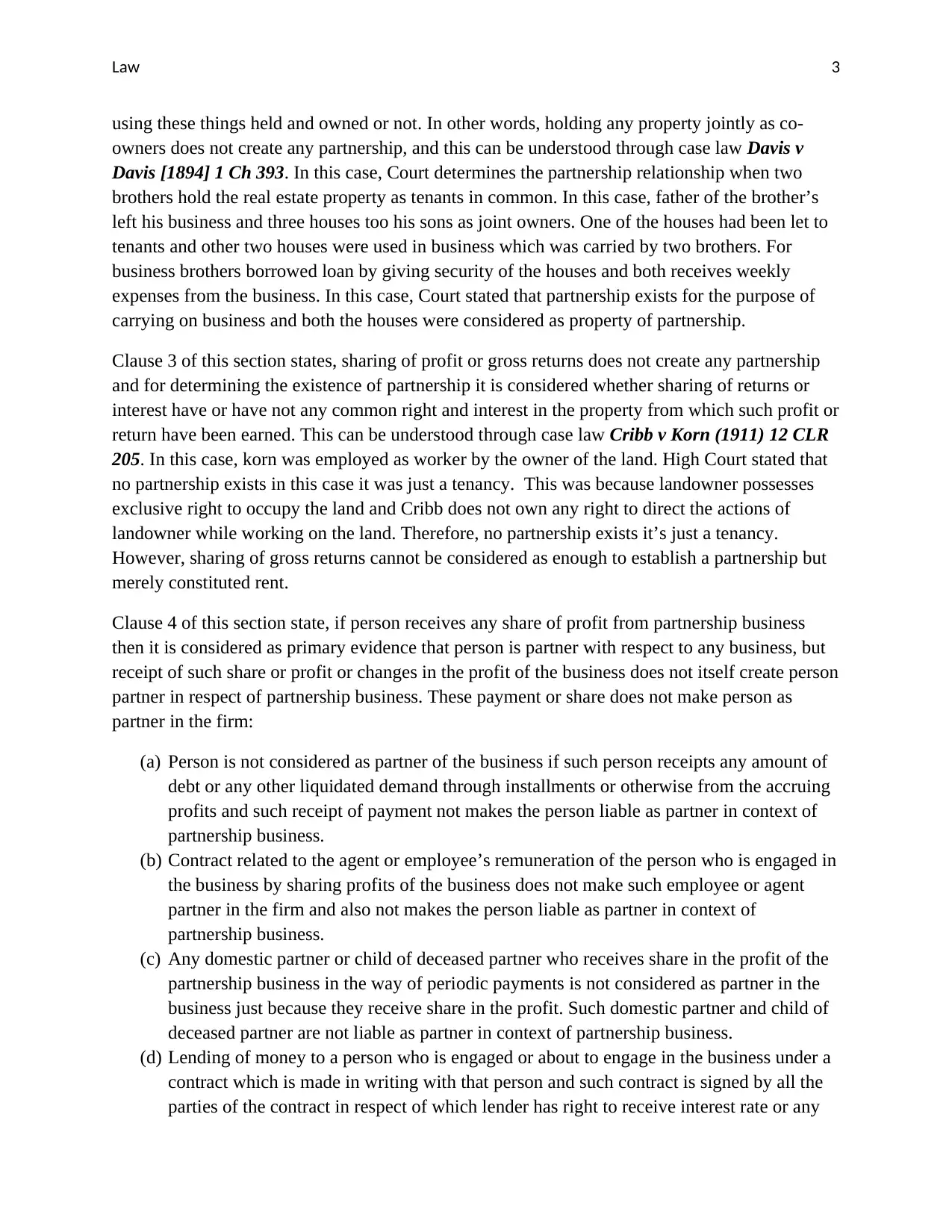
Law 3
using these things held and owned or not. In other words, holding any property jointly as co-
owners does not create any partnership, and this can be understood through case law Davis v
Davis [1894] 1 Ch 393. In this case, Court determines the partnership relationship when two
brothers hold the real estate property as tenants in common. In this case, father of the brother’s
left his business and three houses too his sons as joint owners. One of the houses had been let to
tenants and other two houses were used in business which was carried by two brothers. For
business brothers borrowed loan by giving security of the houses and both receives weekly
expenses from the business. In this case, Court stated that partnership exists for the purpose of
carrying on business and both the houses were considered as property of partnership.
Clause 3 of this section states, sharing of profit or gross returns does not create any partnership
and for determining the existence of partnership it is considered whether sharing of returns or
interest have or have not any common right and interest in the property from which such profit or
return have been earned. This can be understood through case law Cribb v Korn (1911) 12 CLR
205. In this case, korn was employed as worker by the owner of the land. High Court stated that
no partnership exists in this case it was just a tenancy. This was because landowner possesses
exclusive right to occupy the land and Cribb does not own any right to direct the actions of
landowner while working on the land. Therefore, no partnership exists it’s just a tenancy.
However, sharing of gross returns cannot be considered as enough to establish a partnership but
merely constituted rent.
Clause 4 of this section state, if person receives any share of profit from partnership business
then it is considered as primary evidence that person is partner with respect to any business, but
receipt of such share or profit or changes in the profit of the business does not itself create person
partner in respect of partnership business. These payment or share does not make person as
partner in the firm:
(a) Person is not considered as partner of the business if such person receipts any amount of
debt or any other liquidated demand through installments or otherwise from the accruing
profits and such receipt of payment not makes the person liable as partner in context of
partnership business.
(b) Contract related to the agent or employee’s remuneration of the person who is engaged in
the business by sharing profits of the business does not make such employee or agent
partner in the firm and also not makes the person liable as partner in context of
partnership business.
(c) Any domestic partner or child of deceased partner who receives share in the profit of the
partnership business in the way of periodic payments is not considered as partner in the
business just because they receive share in the profit. Such domestic partner and child of
deceased partner are not liable as partner in context of partnership business.
(d) Lending of money to a person who is engaged or about to engage in the business under a
contract which is made in writing with that person and such contract is signed by all the
parties of the contract in respect of which lender has right to receive interest rate or any
using these things held and owned or not. In other words, holding any property jointly as co-
owners does not create any partnership, and this can be understood through case law Davis v
Davis [1894] 1 Ch 393. In this case, Court determines the partnership relationship when two
brothers hold the real estate property as tenants in common. In this case, father of the brother’s
left his business and three houses too his sons as joint owners. One of the houses had been let to
tenants and other two houses were used in business which was carried by two brothers. For
business brothers borrowed loan by giving security of the houses and both receives weekly
expenses from the business. In this case, Court stated that partnership exists for the purpose of
carrying on business and both the houses were considered as property of partnership.
Clause 3 of this section states, sharing of profit or gross returns does not create any partnership
and for determining the existence of partnership it is considered whether sharing of returns or
interest have or have not any common right and interest in the property from which such profit or
return have been earned. This can be understood through case law Cribb v Korn (1911) 12 CLR
205. In this case, korn was employed as worker by the owner of the land. High Court stated that
no partnership exists in this case it was just a tenancy. This was because landowner possesses
exclusive right to occupy the land and Cribb does not own any right to direct the actions of
landowner while working on the land. Therefore, no partnership exists it’s just a tenancy.
However, sharing of gross returns cannot be considered as enough to establish a partnership but
merely constituted rent.
Clause 4 of this section state, if person receives any share of profit from partnership business
then it is considered as primary evidence that person is partner with respect to any business, but
receipt of such share or profit or changes in the profit of the business does not itself create person
partner in respect of partnership business. These payment or share does not make person as
partner in the firm:
(a) Person is not considered as partner of the business if such person receipts any amount of
debt or any other liquidated demand through installments or otherwise from the accruing
profits and such receipt of payment not makes the person liable as partner in context of
partnership business.
(b) Contract related to the agent or employee’s remuneration of the person who is engaged in
the business by sharing profits of the business does not make such employee or agent
partner in the firm and also not makes the person liable as partner in context of
partnership business.
(c) Any domestic partner or child of deceased partner who receives share in the profit of the
partnership business in the way of periodic payments is not considered as partner in the
business just because they receive share in the profit. Such domestic partner and child of
deceased partner are not liable as partner in context of partnership business.
(d) Lending of money to a person who is engaged or about to engage in the business under a
contract which is made in writing with that person and such contract is signed by all the
parties of the contract in respect of which lender has right to receive interest rate or any
⊘ This is a preview!⊘
Do you want full access?
Subscribe today to unlock all pages.

Trusted by 1+ million students worldwide
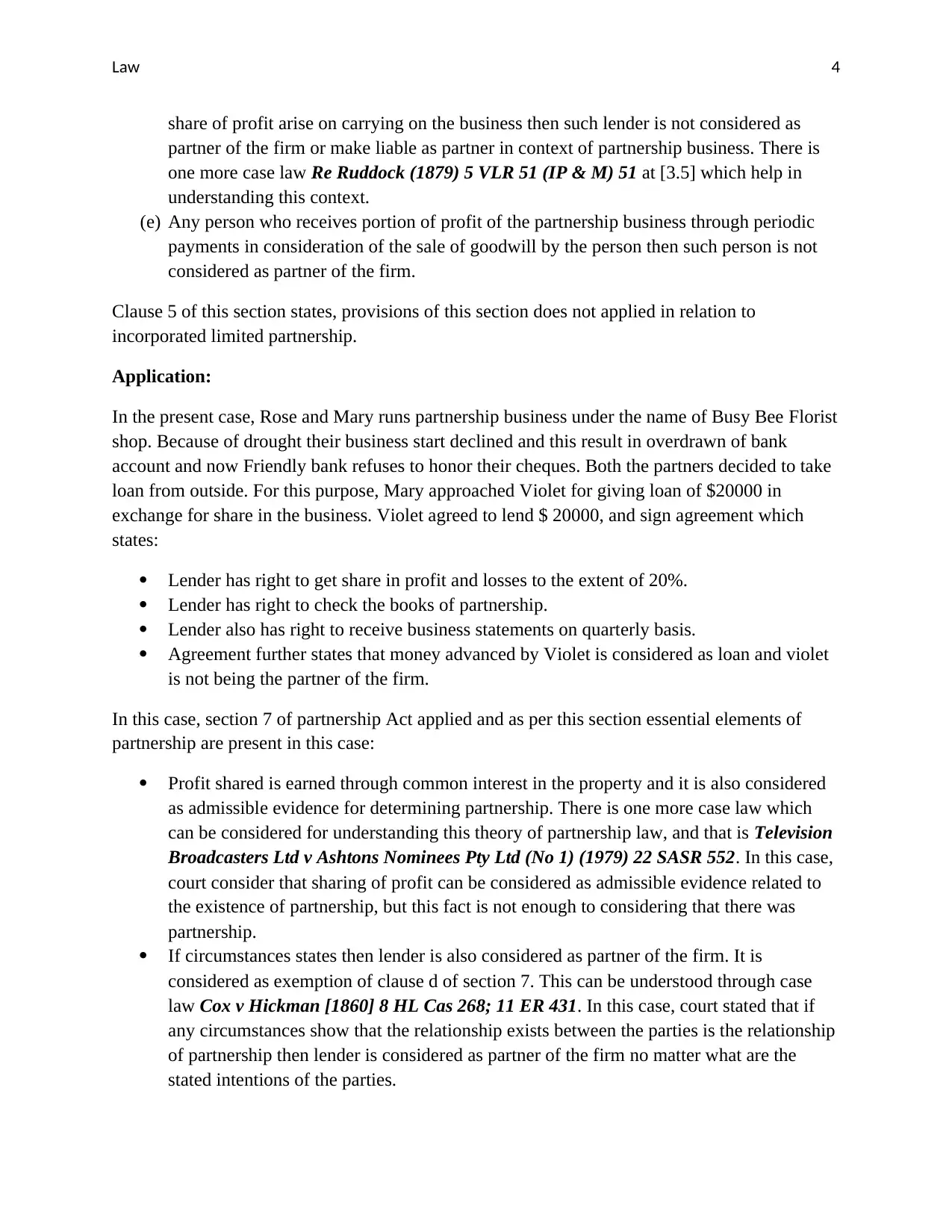
Law 4
share of profit arise on carrying on the business then such lender is not considered as
partner of the firm or make liable as partner in context of partnership business. There is
one more case law Re Ruddock (1879) 5 VLR 51 (IP & M) 51 at [3.5] which help in
understanding this context.
(e) Any person who receives portion of profit of the partnership business through periodic
payments in consideration of the sale of goodwill by the person then such person is not
considered as partner of the firm.
Clause 5 of this section states, provisions of this section does not applied in relation to
incorporated limited partnership.
Application:
In the present case, Rose and Mary runs partnership business under the name of Busy Bee Florist
shop. Because of drought their business start declined and this result in overdrawn of bank
account and now Friendly bank refuses to honor their cheques. Both the partners decided to take
loan from outside. For this purpose, Mary approached Violet for giving loan of $20000 in
exchange for share in the business. Violet agreed to lend $ 20000, and sign agreement which
states:
Lender has right to get share in profit and losses to the extent of 20%.
Lender has right to check the books of partnership.
Lender also has right to receive business statements on quarterly basis.
Agreement further states that money advanced by Violet is considered as loan and violet
is not being the partner of the firm.
In this case, section 7 of partnership Act applied and as per this section essential elements of
partnership are present in this case:
Profit shared is earned through common interest in the property and it is also considered
as admissible evidence for determining partnership. There is one more case law which
can be considered for understanding this theory of partnership law, and that is Television
Broadcasters Ltd v Ashtons Nominees Pty Ltd (No 1) (1979) 22 SASR 552. In this case,
court consider that sharing of profit can be considered as admissible evidence related to
the existence of partnership, but this fact is not enough to considering that there was
partnership.
If circumstances states then lender is also considered as partner of the firm. It is
considered as exemption of clause d of section 7. This can be understood through case
law Cox v Hickman [1860] 8 HL Cas 268; 11 ER 431. In this case, court stated that if
any circumstances show that the relationship exists between the parties is the relationship
of partnership then lender is considered as partner of the firm no matter what are the
stated intentions of the parties.
share of profit arise on carrying on the business then such lender is not considered as
partner of the firm or make liable as partner in context of partnership business. There is
one more case law Re Ruddock (1879) 5 VLR 51 (IP & M) 51 at [3.5] which help in
understanding this context.
(e) Any person who receives portion of profit of the partnership business through periodic
payments in consideration of the sale of goodwill by the person then such person is not
considered as partner of the firm.
Clause 5 of this section states, provisions of this section does not applied in relation to
incorporated limited partnership.
Application:
In the present case, Rose and Mary runs partnership business under the name of Busy Bee Florist
shop. Because of drought their business start declined and this result in overdrawn of bank
account and now Friendly bank refuses to honor their cheques. Both the partners decided to take
loan from outside. For this purpose, Mary approached Violet for giving loan of $20000 in
exchange for share in the business. Violet agreed to lend $ 20000, and sign agreement which
states:
Lender has right to get share in profit and losses to the extent of 20%.
Lender has right to check the books of partnership.
Lender also has right to receive business statements on quarterly basis.
Agreement further states that money advanced by Violet is considered as loan and violet
is not being the partner of the firm.
In this case, section 7 of partnership Act applied and as per this section essential elements of
partnership are present in this case:
Profit shared is earned through common interest in the property and it is also considered
as admissible evidence for determining partnership. There is one more case law which
can be considered for understanding this theory of partnership law, and that is Television
Broadcasters Ltd v Ashtons Nominees Pty Ltd (No 1) (1979) 22 SASR 552. In this case,
court consider that sharing of profit can be considered as admissible evidence related to
the existence of partnership, but this fact is not enough to considering that there was
partnership.
If circumstances states then lender is also considered as partner of the firm. It is
considered as exemption of clause d of section 7. This can be understood through case
law Cox v Hickman [1860] 8 HL Cas 268; 11 ER 431. In this case, court stated that if
any circumstances show that the relationship exists between the parties is the relationship
of partnership then lender is considered as partner of the firm no matter what are the
stated intentions of the parties.
Paraphrase This Document
Need a fresh take? Get an instant paraphrase of this document with our AI Paraphraser
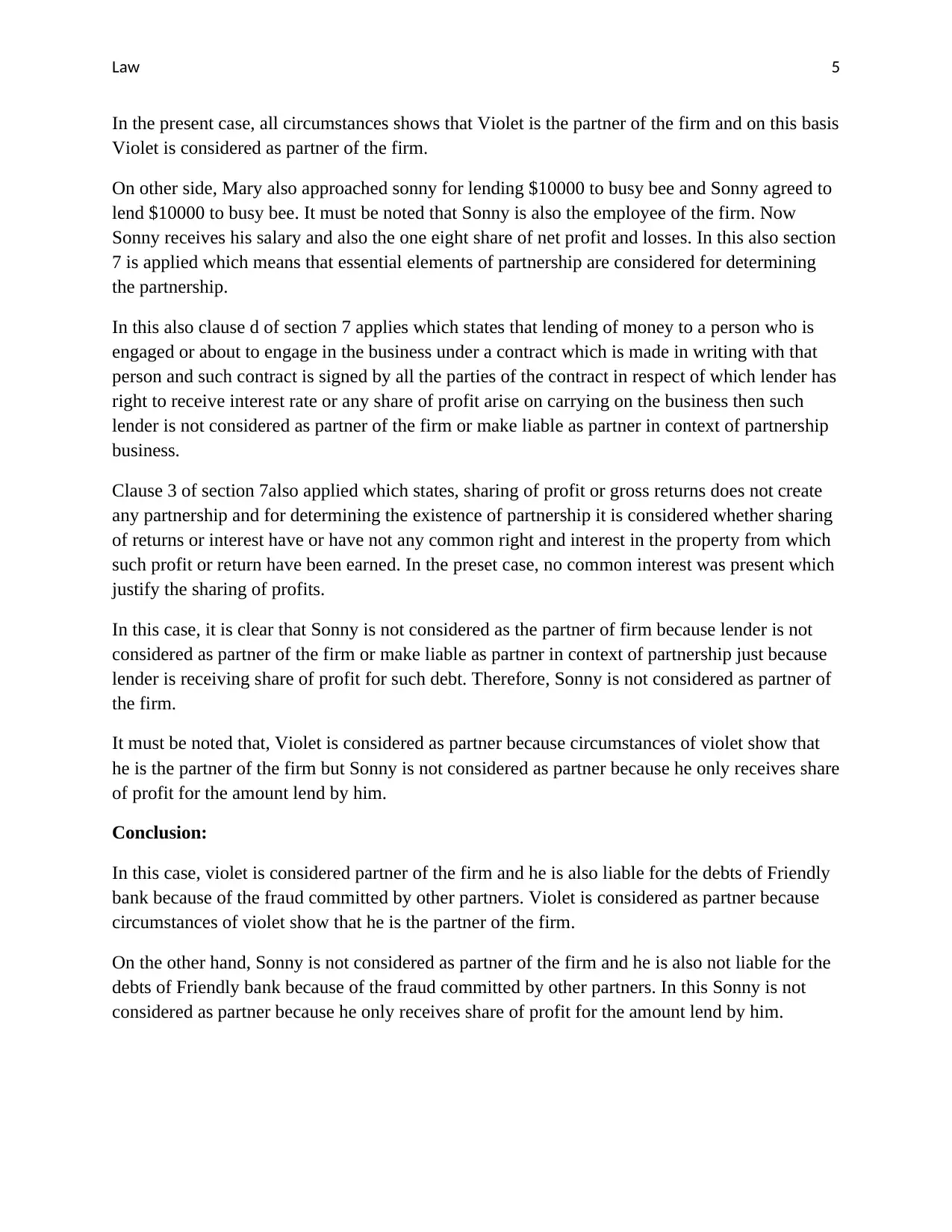
Law 5
In the present case, all circumstances shows that Violet is the partner of the firm and on this basis
Violet is considered as partner of the firm.
On other side, Mary also approached sonny for lending $10000 to busy bee and Sonny agreed to
lend $10000 to busy bee. It must be noted that Sonny is also the employee of the firm. Now
Sonny receives his salary and also the one eight share of net profit and losses. In this also section
7 is applied which means that essential elements of partnership are considered for determining
the partnership.
In this also clause d of section 7 applies which states that lending of money to a person who is
engaged or about to engage in the business under a contract which is made in writing with that
person and such contract is signed by all the parties of the contract in respect of which lender has
right to receive interest rate or any share of profit arise on carrying on the business then such
lender is not considered as partner of the firm or make liable as partner in context of partnership
business.
Clause 3 of section 7also applied which states, sharing of profit or gross returns does not create
any partnership and for determining the existence of partnership it is considered whether sharing
of returns or interest have or have not any common right and interest in the property from which
such profit or return have been earned. In the preset case, no common interest was present which
justify the sharing of profits.
In this case, it is clear that Sonny is not considered as the partner of firm because lender is not
considered as partner of the firm or make liable as partner in context of partnership just because
lender is receiving share of profit for such debt. Therefore, Sonny is not considered as partner of
the firm.
It must be noted that, Violet is considered as partner because circumstances of violet show that
he is the partner of the firm but Sonny is not considered as partner because he only receives share
of profit for the amount lend by him.
Conclusion:
In this case, violet is considered partner of the firm and he is also liable for the debts of Friendly
bank because of the fraud committed by other partners. Violet is considered as partner because
circumstances of violet show that he is the partner of the firm.
On the other hand, Sonny is not considered as partner of the firm and he is also not liable for the
debts of Friendly bank because of the fraud committed by other partners. In this Sonny is not
considered as partner because he only receives share of profit for the amount lend by him.
In the present case, all circumstances shows that Violet is the partner of the firm and on this basis
Violet is considered as partner of the firm.
On other side, Mary also approached sonny for lending $10000 to busy bee and Sonny agreed to
lend $10000 to busy bee. It must be noted that Sonny is also the employee of the firm. Now
Sonny receives his salary and also the one eight share of net profit and losses. In this also section
7 is applied which means that essential elements of partnership are considered for determining
the partnership.
In this also clause d of section 7 applies which states that lending of money to a person who is
engaged or about to engage in the business under a contract which is made in writing with that
person and such contract is signed by all the parties of the contract in respect of which lender has
right to receive interest rate or any share of profit arise on carrying on the business then such
lender is not considered as partner of the firm or make liable as partner in context of partnership
business.
Clause 3 of section 7also applied which states, sharing of profit or gross returns does not create
any partnership and for determining the existence of partnership it is considered whether sharing
of returns or interest have or have not any common right and interest in the property from which
such profit or return have been earned. In the preset case, no common interest was present which
justify the sharing of profits.
In this case, it is clear that Sonny is not considered as the partner of firm because lender is not
considered as partner of the firm or make liable as partner in context of partnership just because
lender is receiving share of profit for such debt. Therefore, Sonny is not considered as partner of
the firm.
It must be noted that, Violet is considered as partner because circumstances of violet show that
he is the partner of the firm but Sonny is not considered as partner because he only receives share
of profit for the amount lend by him.
Conclusion:
In this case, violet is considered partner of the firm and he is also liable for the debts of Friendly
bank because of the fraud committed by other partners. Violet is considered as partner because
circumstances of violet show that he is the partner of the firm.
On the other hand, Sonny is not considered as partner of the firm and he is also not liable for the
debts of Friendly bank because of the fraud committed by other partners. In this Sonny is not
considered as partner because he only receives share of profit for the amount lend by him.
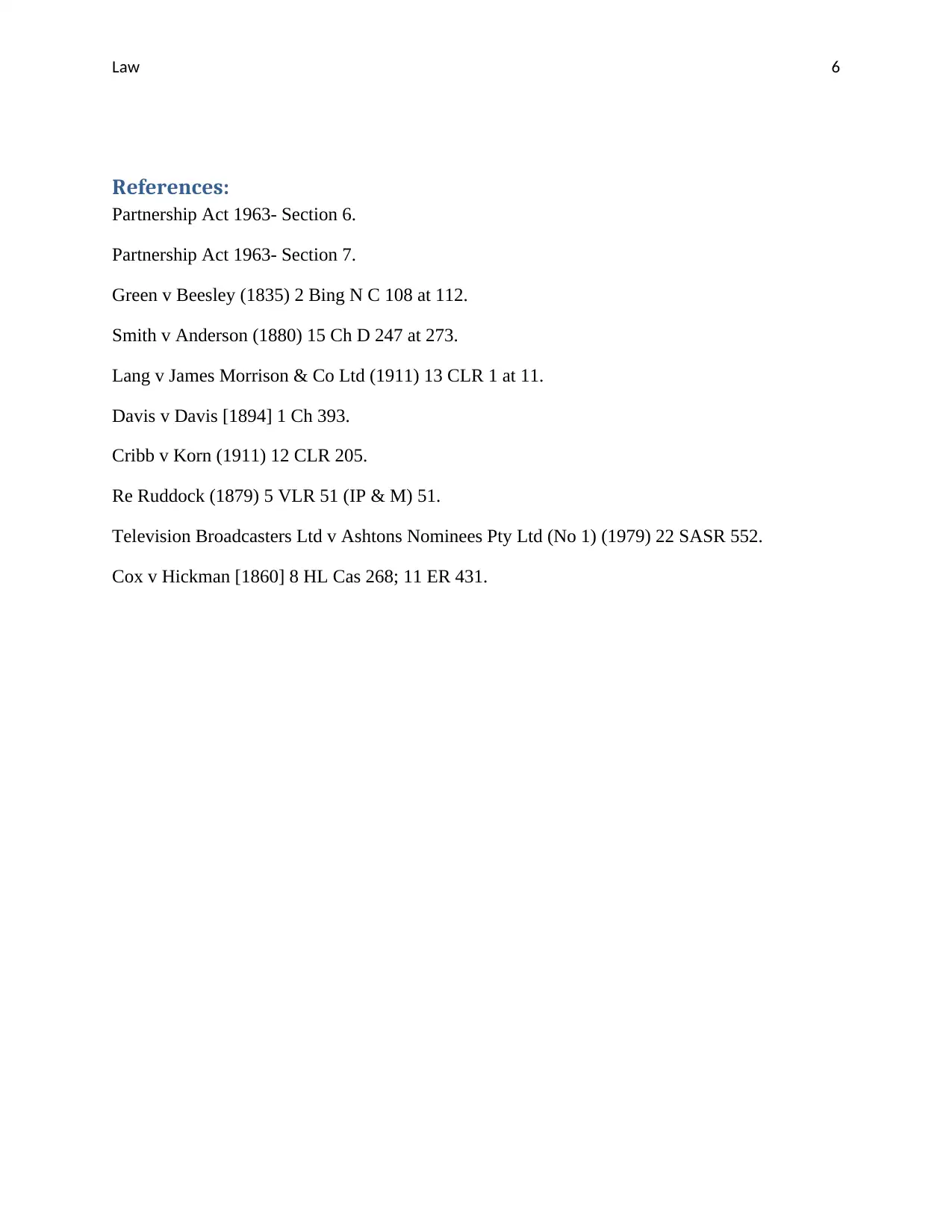
Law 6
References:
Partnership Act 1963- Section 6.
Partnership Act 1963- Section 7.
Green v Beesley (1835) 2 Bing N C 108 at 112.
Smith v Anderson (1880) 15 Ch D 247 at 273.
Lang v James Morrison & Co Ltd (1911) 13 CLR 1 at 11.
Davis v Davis [1894] 1 Ch 393.
Cribb v Korn (1911) 12 CLR 205.
Re Ruddock (1879) 5 VLR 51 (IP & M) 51.
Television Broadcasters Ltd v Ashtons Nominees Pty Ltd (No 1) (1979) 22 SASR 552.
Cox v Hickman [1860] 8 HL Cas 268; 11 ER 431.
References:
Partnership Act 1963- Section 6.
Partnership Act 1963- Section 7.
Green v Beesley (1835) 2 Bing N C 108 at 112.
Smith v Anderson (1880) 15 Ch D 247 at 273.
Lang v James Morrison & Co Ltd (1911) 13 CLR 1 at 11.
Davis v Davis [1894] 1 Ch 393.
Cribb v Korn (1911) 12 CLR 205.
Re Ruddock (1879) 5 VLR 51 (IP & M) 51.
Television Broadcasters Ltd v Ashtons Nominees Pty Ltd (No 1) (1979) 22 SASR 552.
Cox v Hickman [1860] 8 HL Cas 268; 11 ER 431.
⊘ This is a preview!⊘
Do you want full access?
Subscribe today to unlock all pages.

Trusted by 1+ million students worldwide
1 out of 6
Related Documents
Your All-in-One AI-Powered Toolkit for Academic Success.
+13062052269
info@desklib.com
Available 24*7 on WhatsApp / Email
![[object Object]](/_next/static/media/star-bottom.7253800d.svg)
Unlock your academic potential
Copyright © 2020–2025 A2Z Services. All Rights Reserved. Developed and managed by ZUCOL.



